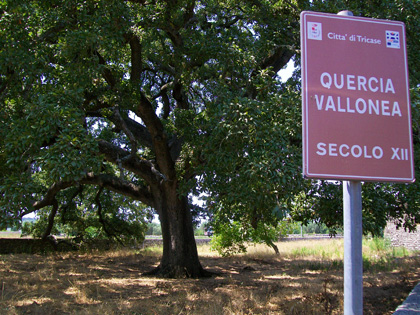
The Mount Tabor Oak of Tricase
This post is also available in:
 Italiano (Italian)
Italiano (Italian)
Quercus ithaburensis subsp. macrolepis (Fagaceae)
The Mount Tabor oak (Quercus ithaburensis subsp. Macrolepis) is a subspecies widespread in the Mediterranean basin, the Balkans, the Greek Islands and in Asia Minor. In Italy, it grows only in Salento, in the province of Lecce and that of Brindisi.
It is not yet clear whether it is a relict species or whether it was introduced around the year 1000 by some Basilian monks from Greece – to extract tannins and use them for dyeing hides.
The latter assumption is based on the fact that leather tanning was a very important local activity until 1800 – when the first synthetic agents were introduced.
Unfortunately, the Italian Mount Tabor oaks have been almost totally destroyed in the last centuries, to use their wood.
In the local dialect, this very oak variety is called “falanida”, “pizzofao” or “lizza-castagna” (the last term refers to the large and sweet acorns which are eaten as if they were chestnuts – “castagna” in Italian).
This beautiful specimen is included in the National “Red List” of rare species threatened of extinction.
It is a tree that usually grows up to 49-82 ft, featuring with a globular crown. The young branches are yellow-brownish, then they get quite smooth and turn grey. It blooms in April. The acorns grow singularly or in very small groups; the can measure up to 1.57 x 0.78 inches and are protected by a hemispherical dome with large scales: they ripe two years after their appearance.
In Tricase, inside the Costa Otranto – Santa Maria di Leuca and Bosco di Trecase Regional Natural Park (on the road leading to the harbour), there is a monumental specimen of Mount Tabor oak: for its rarity, its imposing size (circumference 14 ft, height 72 ft) and its age (around 700 years old), this magnificent trees is one of the most spectacular and important in Italy.
This specimen is also called “The 100 Knight Oak”, because, according to the tradition, Frederick II and his escort found shelter from a storm under its branches, at the end of the XII century.
About thirty years ago, this tree would have been demolished (to build a road), had it not been for a forest inspector who managed to save it. In 2019, it was acknowledged as “Tree of the Italian Year”, thanks to the Friulian association “Giant Trees Foundation” Onlus, which deals with the protection of huge trees around the world, and which has joined the European competition “Tree of The Year”, launched in 2011.
How to get there:
This majestic oak grows along the provincial road that runs from Tricase to Tricase Porto (LE)
Other impressive examples of Mount Tabor oaks can be found in Corignano d’Otranto (49-ft high, with a crown diameter of 65.6 ft), in Taurisano – in front of the church on Via Emile Namer – and another one, very small, near Gallipoli, along the road to Alezio.
Botanical Card:
This species grows in Asia Minor (Palestine), Albania, Greece, Crete and other Aegean islands, as well as in European Turkey and south-eastern Italy (Salento). Its distribution range has been strongly influenced by man. It is a tree that usually grows up to 49-82 ft, featuring with a globular crown. The young branches are yellow-brownish, then they get quite smooth and turn grey. It blooms in April. The acorns grow singularly or in very small groups; the can measure up to 1.57 x 0.78 inches and are protected by a hemispherical dome with large scales: they ripe two years after their appearance.
This is a semi-deciduous, heliophilous and highly xerophilous species, while it can withstand temperatures. It prefers calcareous soils but not necessarily a fertile one.
The domes of the acorns contain up to 50% of high-quality tannin, once used for the tanning of the skins and then replaced by that of chestnuts, much cheaper.
Photo source:
This post is also available in:
 Italiano (Italian)
Italiano (Italian)
Contatti
73039 Tricase(LE)
